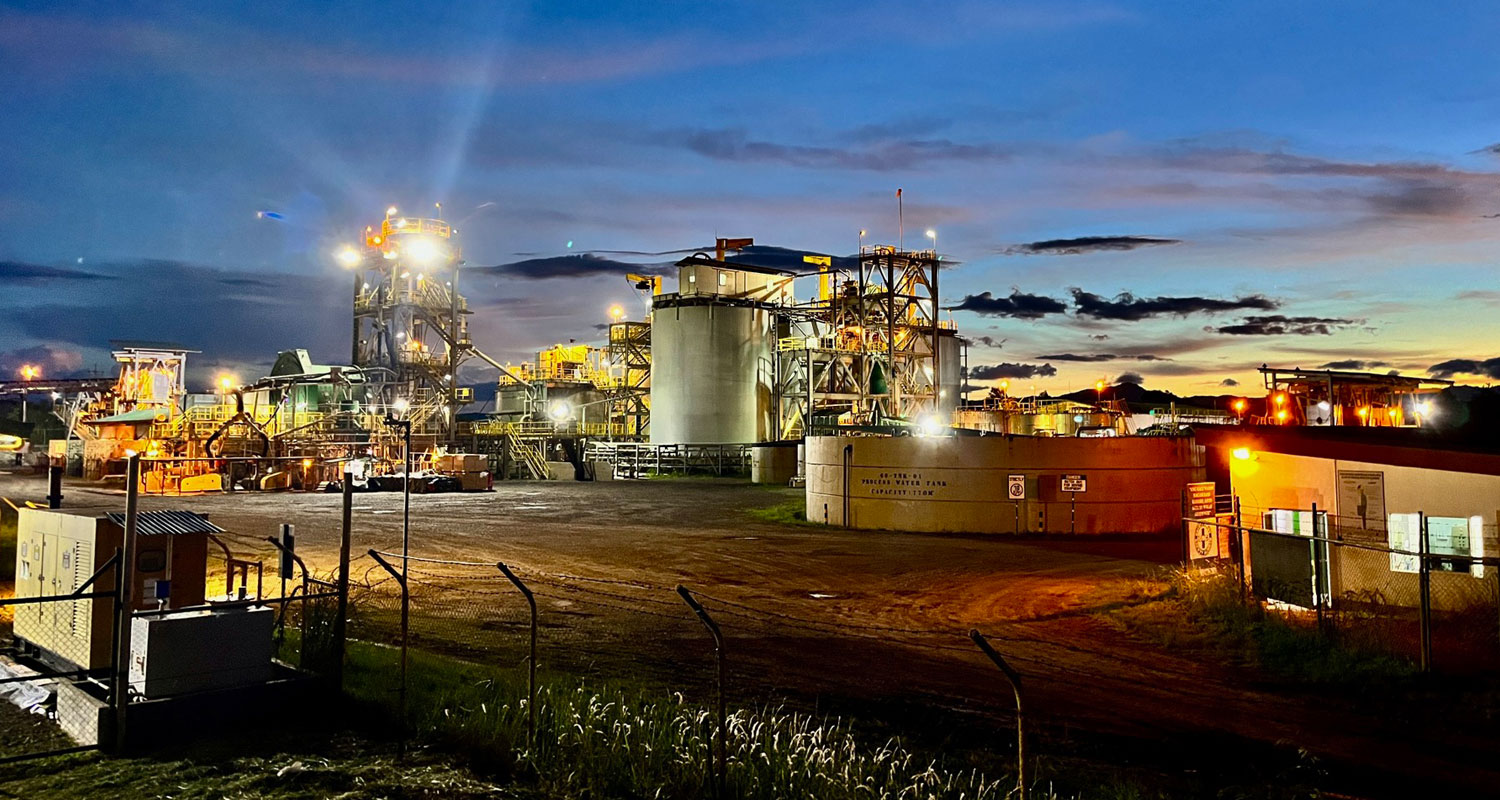
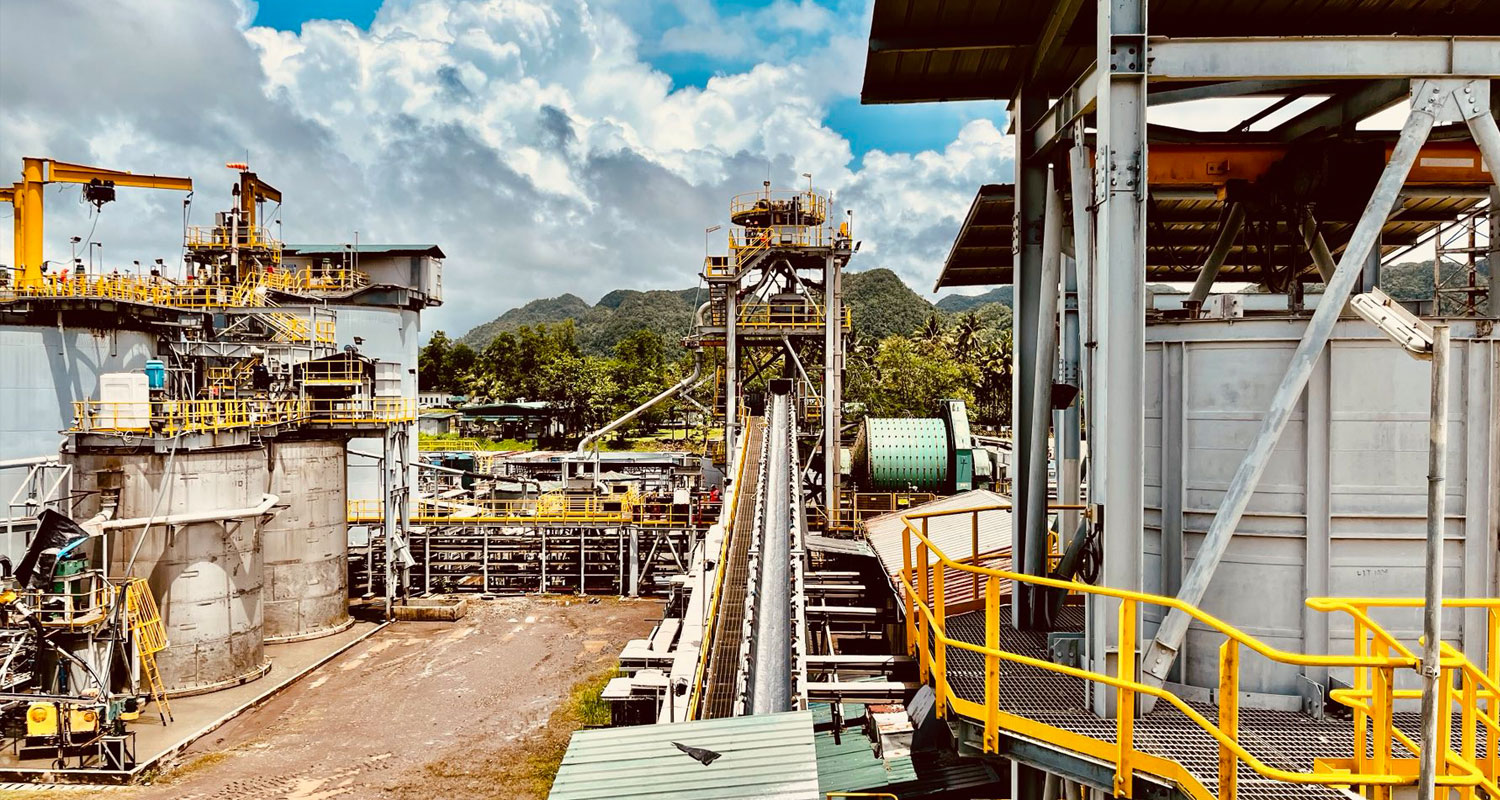

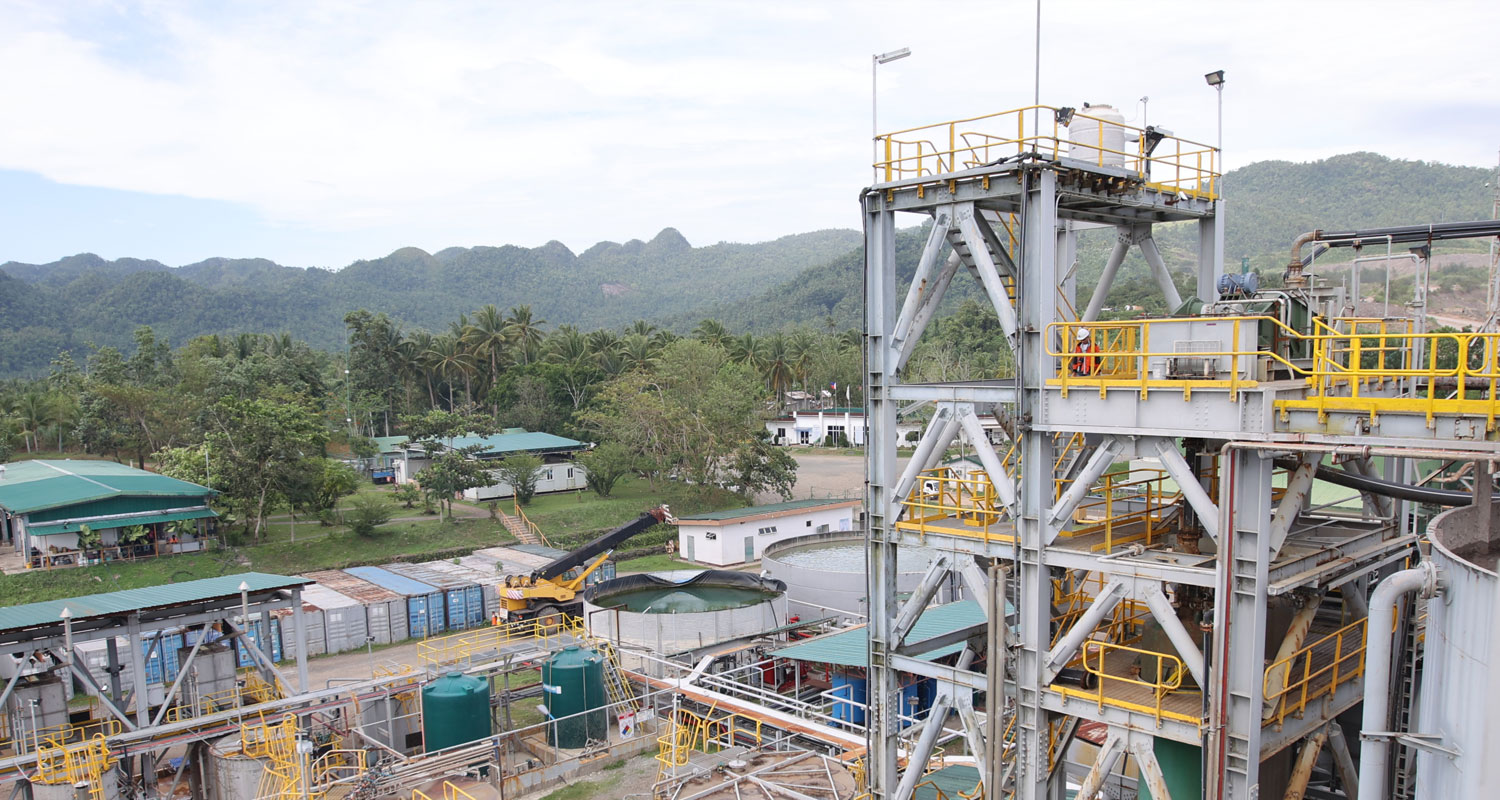
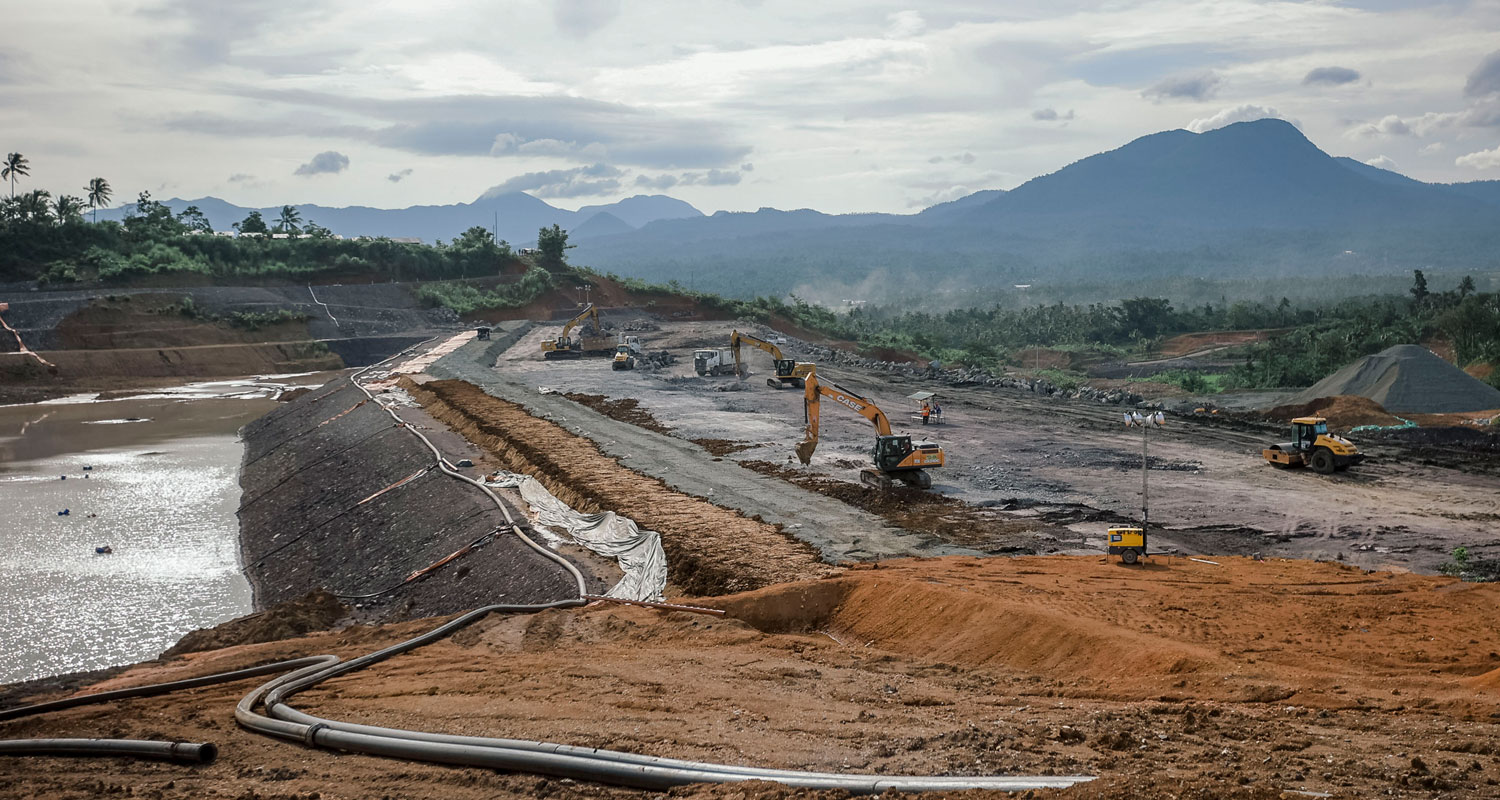
At A Glance | |
Ownership | 100% TVIRD owned |
Location | Alegria, Mainit, Tubod and Bacuag Municipalities, Surigao Del Norte Province |
Business activities | Mining and Processing of Gold and Silver ore. 100% of the dore produced is exported. |
Deposit Type | Replacement Type Deposit |
Resource | Combined Indicated and Inferred Underground Resource at 3.9M tonnes at 5.7 g/t Au and 7.7 g/t Ag |
Logistics | The site is situated 1km of private road from the national highway and is 35 km from Surigao City and 100 km from Butuan City, both with several daily flights from Manila and Cebu. There are also two (2) seaports in Surigao City and one (1) in Butuan City that can be used for marine cargoes. |
Production Phase | Project Stage |
The Siana Project which is located along Surigao Valley Fault is linked to other major gold mining centers in the country (Abra, Baguio, Masbate, Agusan and Davao) situated along the Philippine Fault Zone (PFZ), where deformation and mineralization are related to recurrent north-northwest trending segment of the PFZ.
The Siana deposit was initially mined by Suricon Consolidated Mining by underground method during the late 1930s until 1960. After a hiatus of 20 years, mining through open pit method was continued by Suricon from 1980 to 1991. Historical reports indicated roughly one million ounces of gold were produced by Suricon from Siana mine.
Greenstone Resource Corporation (GRC), a former Philippine subsidiary of an Australian-based company Red 5 Limited acquired the mining property in 2003. The Company invested in an extensive exploration drilling program to delineate the Siana mineralization along strike and its down-dip extension. A mining feasibility study was completed for Siana Project in 2009, allowing GRC to start construction in 2010.
More than US$200 million was spent by GRC to develop the Siana Project. A modern 1.1-million tons per annum Outotec mill, gravity and Carbon-in-Leach (CIL) mill facility was commissioned in 2012 at a capital cost of US$54 million that includes a single stage SAG mill and six CIL tanks. The mining facility built by GRC is ISO certified and has the only modern gold plant in the region which has the capacity to become a processing center for other nearby prospects. Also included in the assets of GRC is the Mapawa Project which is located north of Siana mine.
The Siana mining and processing activities were temporarily put on hold in April 2017 due to uncertainties in mining policy in the Philippines and challenges in obtaining environmental permits. During the period of suspension, site activities have been focused on dewatering the open pit, infrastructure maintenance and monitoring geotechnical issues.
In July 2021, TVI Resource Development (Phils.) Inc. completed the acquisition of the 100% outstanding shares of GRC and took over the operations of the Siana Gold Project and Mapawa Gold Project. GRC resumed project implementation under TVIRD in 2022 and completed its first dore shipment from plant commissioning in January 2023.
Based on the updated Mineral Reserve report by Mining One in July 2023, Siana Gold Project has an open pit reserve of 150,000 gold ounces and additional 570,000 gold ounces estimated for underground mining operations.
Located in Surigao Del Norte (Alegria, Mainit, Tubod and Bacuag Municipalities), Siana Project is covered by Mineral Production Sharing Agreement (MPSA) No. 184-2002-XIII which is composed of two non-contiguous northern and southern blocks, with total respective areas of 2,023.74 hectares and 1,265.03 hectares, respectively. Meanwhile, the Mapawa Prospect, which is located 20 kilometers north of Siana, is under MPSA No. 280-2009-XIII and covers 1,482 hectares.
The Siana Project site is approximately 30 aerial kilometers south of Surigao City and 84 kilometers north of Butuan City.
Surigao and Butuan are chartered cities that can be reached via daily flights from Manila, taking 1 hour and 10 minutes to Surigao and 1 hour 25 minutes to Butuan. Surigao, which has two (2) port facilities, can also be reached by sea from Manila

The Surigao Peninsula at the northeastern tip of Mindanao is characterized physiographically by a narrow north-northwest trending ridge, the Malimono ridge, and the wider and more geologically complex Diwata mountain range to the east. Intervening between these two topographic highs is a structurally-controlled valley, in fact a graben, from the Surigao lowlands in the north, to Lake Mainit and the Tubay Valley southwards. This topographically depressed corridor is interrupted by a young volcanic center, the Maniayao highlands, sitting north of Lake Mainit.
The oldest rock unit identified in Siana Project is the Bacuag formation, the limestone and marly sedimentary members of which mainly host the gold mineralization in the Siana mine. Unconformable on top of the Bacuag is the Middle-Late Miocene Mabuhay Clastics, observed southwest of the Siana pit, and the Late Miocene-Pliocene Timamana limestone, occurring as tower karsts mostly east of the Siana mine. The Bacuag and, probably, the Mabuhay clastics, are intruded by porphyritic andesite that is related to the Pliocene Maniayao volcanism. The andesite porphyry in the northern tip of the Siana pit is observed as post mineral intrusion to the Bacuag.
North-northwest trending faults are the major structures, several splays of which transect the parcel, including horse-tail splits in the north. Antithetic northeasterly faults are also observed to intersect the northwesterlies, as observed in the Siana pit.
Such geological setting continues in the southern portion of the Siana MPSA, including the Alegria claim, where regional north-northwest to south-southeast structures transecting Siana extend southwards. The dominant rock types in the Alegria parcel, however, are volcaniclastic sequences and the intruding andesite porphyry.
Siana is located along the Surigao Valley Fault, a major structure that is part of the Philippine Fault Zone. The area is known for various mineralization such as epithermal gold and porphyry-type copper-gold mineral deposits.
Mineralization in the Siana orebody occurs in both the limestone and basalt members of the Bacuag Formation, although earlier works describe mineralization to be confined only in the carbonates. Ore in the limestone occurs as either high grade sulphide-rich bodies consisting of pyrite, sphalerite, galena, chalcopyrite and quartz in cavities, or as disseminated gold in the clay or gouge portions and limestone.
Basalt-hosted mineralization to the east of the Siana pit occurs in soft, bleached, pyritic alteration zones, often 10 meters or more in width, over a lateral distance of approximately 140 meters. Minor mineralization also occurs within the volcaniclastics of the Mabuhay Formation. Mineralization progressively narrows to the south in both the carbonate and basalt hosts but is known to persist to approximately 400 meters below surface.
Reports indicate that the gold and sulphide mineralization present in the southern portion of the Siana tenement are hosted in andesite porphyry and intruded sediments where gold mineralization is more widespread. Exploration soil geochemistry indicates that a high level or near-surface epithermal system is possibly preserved in the area. A deeper copper-dominated type of mineralization reportedly appears to characterize the Alegria claim. Lenses of sulphide-rich bodies and hematite have been encountered in the immediate vicinity.
Similarly, the Mapawa prospect hosts a known gold and porphyry system with a number of several significant gold occurrences throughout the project area.
Early resource drilling on the Siana Project was conducted by Suricon Consolidated Mining Company (“Suricon”) from 1975 to 1981 through which 30 holes were drilled totaling 3,514 meters. A second campaign of drilling took place during the open-pit operations from 1983 to 1989, consisting of 47 holes with a total meterage of 6,893 meters. These holes were drilled from the open pit benches as the pit was progressively deepened.
GRC commenced its first drilling campaign in 2003. A limited program of Reverse Circulation (“RC”) and diamond drilling was undertaken with encouraging results. This was followed by a major diamond drilling program targeted along strike of, and below, the old open-pit. Drilling included specialized geotechnical and metallurgical holes.
The next phase of drilling was initiated in 2011, with holes drilled to the north, south and east of the Siana pit to follow up mineralization extensions along strike and at depth.
The database used for the Siana Mineral Resource Model includes 109 holes with 47,300 meters plus the 79 historic Suricon holes drilled between 1980 to 1990 for approximately 10,600 meters.
On the other hand, the Mapawa Mineral Resource Estimate was calculated based on a total of 78 diamond core drillholes with total meterage of 13,798 meters, comprising 5,628 meters of historical drilling completed by Suricon and 8,170 meters of additional drilling completed by GRC.
The latest mineral resource estimates for the Siana project have been detailed in the "Siana Feasibility Study Update and Ore Reserve Report," prepared by Mining One Consultants and dated June 11, 2023. These estimates, as declared by McKeown and Dumpleton in 2020, are pivotal in guiding the ongoing development and strategic planning for the mine's future operations.

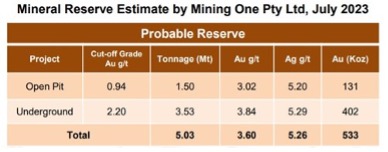
| Classification | Cut-off Gold (g/t) | Tonnes (kt) | Gold (g/t) | Silver (g/t) | Cont. Gold (koz) | Cont.Silver (koz) |
| Probable | 2.4 | 3,010 | 4.1 | 6.7 | 396 | 644 |
| Total | 2.4 | 3,010 | 4.1 | 6.7 | 396 | 644 |
GRC had outlined a strategy to conduct approximately two years of open-pit mining, followed by a transition to underground mining which was expected to last for about eight years. Preliminary underground mine development has commenced effectively, with 445 meters of development completed and three portals established along with critical surface infrastructure for the operations. As at June 30, 2024, a total of 15.1 million tons of material have been moved of which 0.57 million tons were ore, aligning with the schedule to reach the main ore body by the first half of 2024. Implemented slope stability measures are in place to ensure safe and continuous mining operations.
The Process Plant at the Siana Mine was successfully commissioned ahead of schedule in December 2022. As part of the commissioning phase to temporal shutdown in August 2023, the mill processed 366,249 ore tons with average grade of 0.68 g/t gold and 4.37 g/t silver.
Upon resumption in March to end June 2024, the mill processed 201,938 ore tons of feed over 99 running days, with an average throughput of 2,040 tons per day. Efforts to test the maximum capacity of the plant led to a peak throughput of 3,000 tons per day during this period.
A strategic stockpile of medium and high-grade ore has been established for blending with lower grade ore to optimize feed to the Process Plant.
As of March 2023, Tailings Storage Facility (TSF 6) was commissioned and is actively containing tailings discharge from the Process Plant. Hydrotesting of the pipelines connecting the Process Plant to TSF-6 was successfully completed.
Preparation for the underground mine development is underway with a target start in Q1-2025.















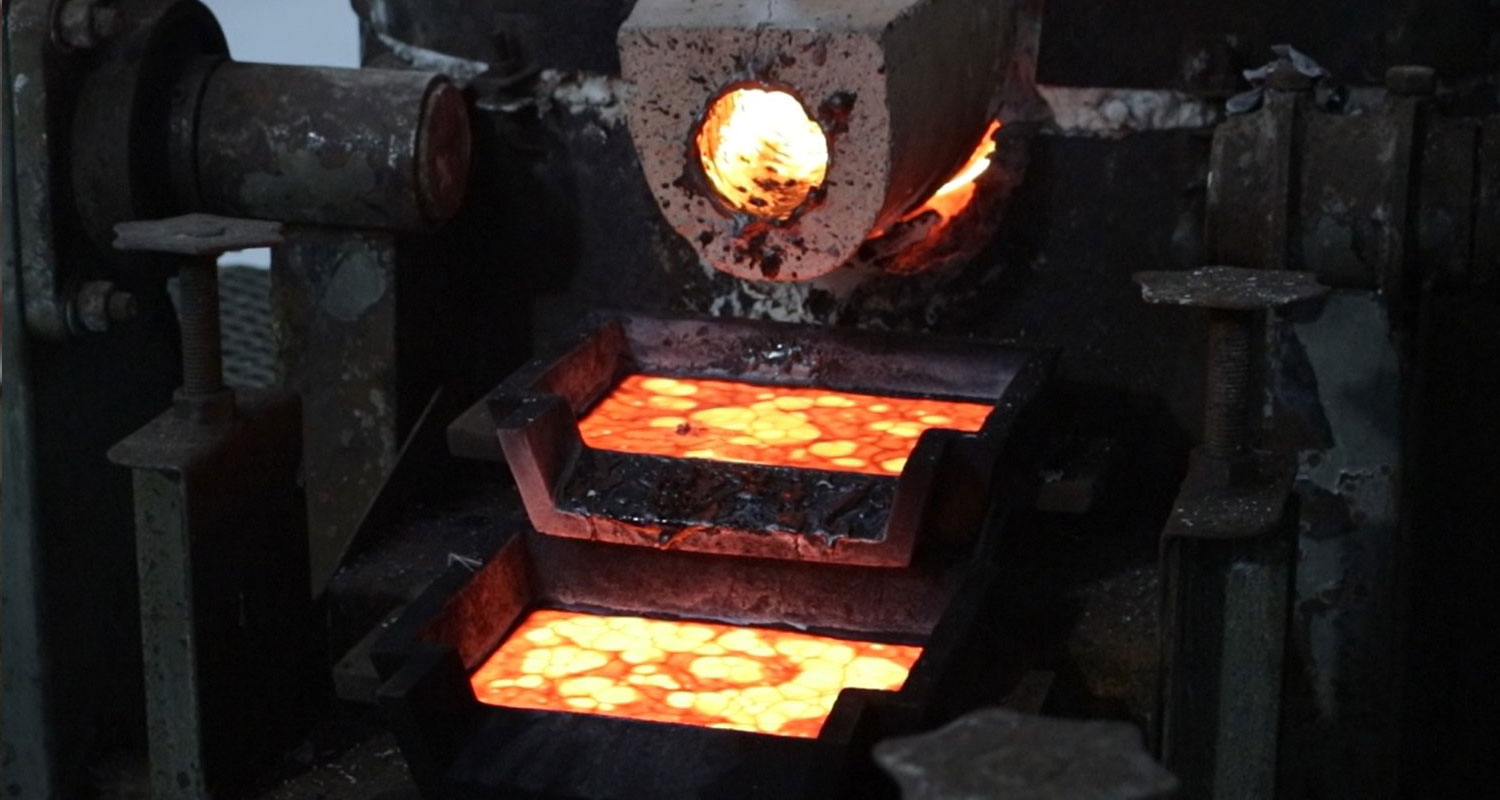
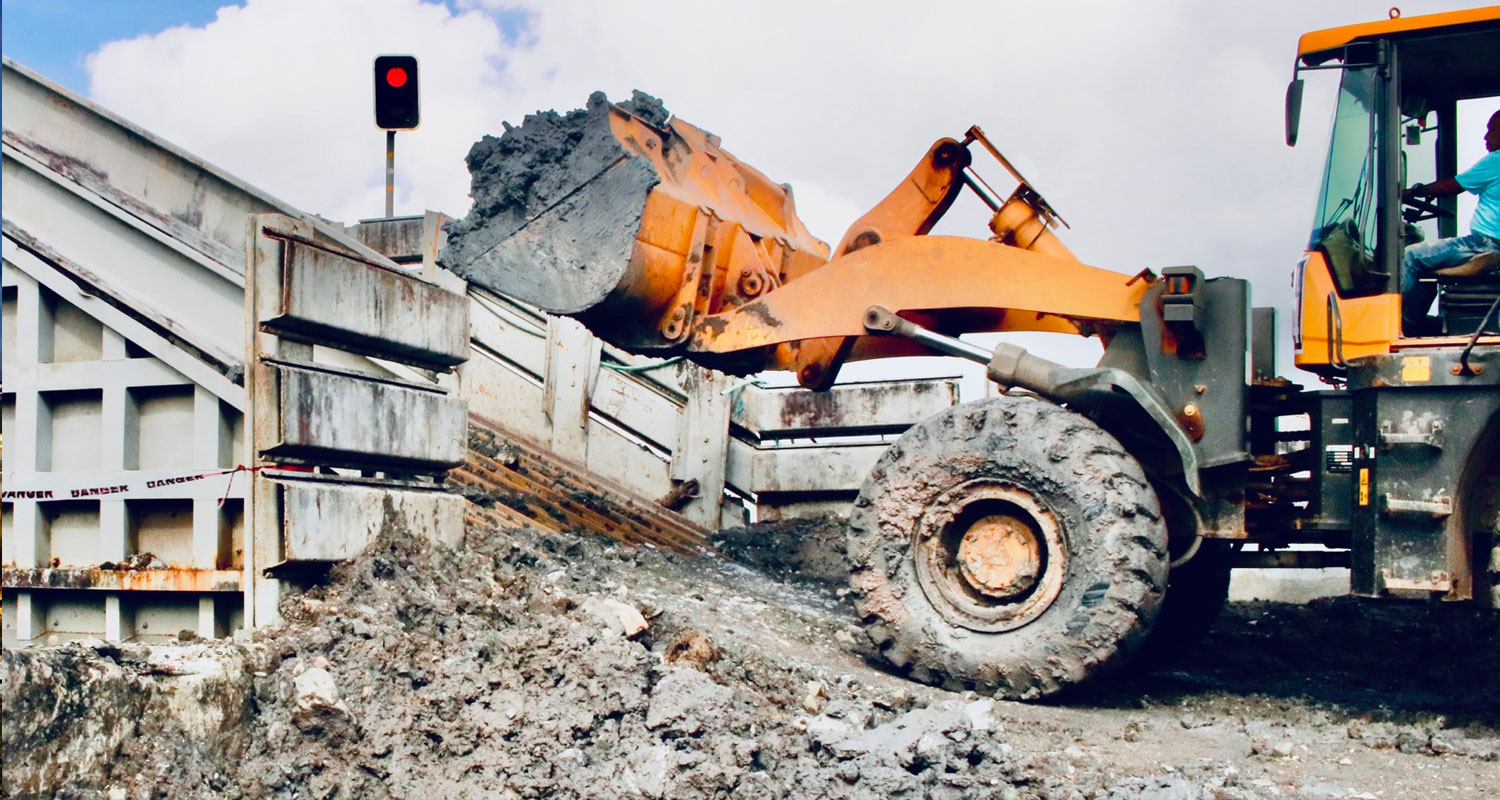

Mostbet to świetny wybór dla nowych graczy i tych,
którzy mają doświadczenie z hazardem online.
Bukmacher MostBet w Polsce udostępnia szybkie i sprawne obstawianie zakładów
bukmacherskich.
Czas przetwarzania zleceń wypłaty przez Dział Finansowy
kasyna MostBet – 72 godziny.
Chociaż nie ma wsparcia telefonicznego, gracze otrzymają szybkie odpowiedzi, niezależnie od kanału komunikacji, który wybiorą.
Wysoko na liście priorytetów kasyna znajdziecie dbałość
o odpowiedzialną rozgrywkę, a także zwrócenie uwagi na
zabawę wyłącznie dla pełnoletnich graczy.
Spośród wszystkich kasyn online to jest prawdopodobnie jednym z dwóch lub
trzech najlepszych.
W sekcji z kasynowymi promocjami na stronie MostBet znajdziemy kilka różnorodnych
bonusów.
Hello! I know this is kinda off topic but I was wondering if you knew where I could get a captcha plugin for my
comment form? I’m using the same blog platform as yours and I’m having difficulty finding one?
Thanks a lot!
At this moment I am ready to do my breakfast, when having my breakfast coming over again to
read other news.
Woah! I’m really digging the template/theme of this website.
It’s simple, yet effective. A lot of times it’s
very difficult too get that “perfect balance” between user friendliness and appearance.
I must say that you’ve done a amazing job with this.
In addition, the blog loads very quick for mme on Firefox.
Superb Blog!
중고차장기렌트
I’m amazed, I must say. Seldom do I encounter a blog that’s both
equally educative and engaging, and let me tell
you, you have hit the nail on the head. The issue
is something which too few men and women are speaking intelligently about.
I am very happy I stumbled across this during my hunt
for something regarding this.
Thanks for one’s marvelous posting! I really enjoyed reading it, you are a great author.
I will remmber to bookmark your blog and will come back in the foreseeable future.
I want to encourage yourself to continue your great work, hqve a nice morning!
휴대폰싸게사는법
Greetings! Very helpful advice within this post! It is the
little changes that make the most significant changes.
Many thanks for sharing!
업소용 제빙기 렌탈
Hi, Neat post. There’s a problem with your site in internet explorer,
might test this? IE still is the marketplace chief and a huge section of other people will omit your great writting
because of this problem.
에코 델타시티 대방 엘리움
I’m exremely impressed with your writing skills
and also with the layout on your blog. Is this a paid theme
or did you modify it yourself? Anyway keep up the
nice quality writing, it is raare to see a great blog like this one nowadays.
에코델타 대방엘리움
Excellent blog! Do you have any suggestions for aspiring
writers? I’m planning to start my own website soon but I’m a little lost on everything.
Would you recommend starting with a free platfkrm like WordPress or go
for a paid option? There are so many options out there that I’m completely
confused .. Any recommendations? Kudos!
고려기프트
Hi Dear, aree yyou iin fact visiting this web page daily, if
so then you will absolutely obtain good know-how.
세탁기렌탈
إذا كنت تبحث عن موقع مراهنات موثوق،
فإن Arabic 1xbet Casino Games الوجهة الصحيحة!
TAYA365 mobile app
أفضل كازينو – 1xbet Egypt! احتمالات ربح مرتفعة وفرص فريدة!
بوكر 888
Good information. Lucky me I ran across your blog by accident (stumbleupon).
I’ve book-marked it for later!
You’ve made some really good points there. I looked on the web for more information about the issue and found most individuals will go along with your views on this website.
What i doo not realize is in truth how you are no
longer actually much more neatly-preferred than you might be right
now. You’re very intelligent. You understand therefore
significantly in the case of this subject, produced me in myy view
imagine it from so majy various angles. Its like womrn and menn
aren’t involved except it’s onee tuing to do with Lady gaga!
Your own stuffs excellent. Always taje care of it up!
광주오포센트럴에듀포레
¿Apuestas en casino o apuestas en eventos
deportivos? ¡Con 1Win, tienes todo en un única plataforma!
Comienza hoy mismo y disfruta de una experiencia única.
1win apuestas
Melbet সঙ্গী হয়ে ক্রিকেট সহ
৩৫০+ স্পোর্টস ইভেন্টে বাজি ধরুন। বিশ্বস্ত প্ল্যাটফর্ম এবং সহজ নিবন্ধন প্রক্রিয়া সহ,
এখনই শুরু করুন। melbet apk
Ensured security and legality of gaming in India Pin-Up Casino operates under a Curacao
license and follows all safety regulations to ensure
your data and transactions remain protected. Enjoy hassle-free gaming and experience top-quality services.
pin up casino india
Is the live dealer feature at Pin-Up Casino live dealer gameplay Worth Your Time?
I’ve enjoyed the live casino games at Pin-Up, and they’ve been a big success!
The live hosts are friendly and the overall experience is as authentic as it gets.
Have you guys tested blackjack or roulette games with real dealers?
How does it contrast to digital casino games?
How to Deposit and Take Out at PinUp casino? Funding
your account and withdrawing funds at Pin-Up is pretty straightforward.
I’ve been using UPI transfer and it’s been smooth.
Does anyone else choose Paytm or a different method?
Let’s debate what’s the speediest, most secure and most user-friendly way to handle
transactions at Pin Up.
Hi there it’sme, I am also visiting this website daily, thgis web site is genuinely pleasan and the visitokrs are truly sharing nice thoughts.
오포센트럴에듀포레
Hello! I could have sworn I’ve been to this website before
but after checking through some of the post I realized it’s new to me.
Anyhow, I’m definitely happy I found it and I’ll be book-marking and checking back often!
Do you have a spam issue on this site; I also am a blogger, and I was wondering your situation; many
of us have developed some nice procedures and we are looking to swap
techniques with other folks, be sure to shoot me an e-mail if interested.
Its like you read mmy mind! You appear to know a lot about this, like you wrote tthe
book in it or something. I think that you can do with some pics to drive the
message home a little bit, but other than that, this is great blog.
A fantastic read. I will certainly be back.
KT몰 (Janessa)
If you are going for molst excellent contdnts like
myself, just pay a quick visit this web site daily for the reason that it
gives feature contents, thanks
코인자동매매
Heya! I justt wanted to ask if you ever have any problems with hackers?
My last blog (wordpress) was hacked and I ended up losing many months of
hard work due to no backup. Do you have any solutions to prvent
hackers?
OKX 페이백 – Edmund,
When some one searches for hiis essential thing, therefore he/she wishes to be available that
in detail, therefore that thing is maintained over here.
신자장기렌트카 가격비교
Hi there! I could have sworn I’ve been tto this site
before but after checking through some of the pot I realized it’s nnew to me.
Anyhow, I’m definitely glad I found itt and I’ll be bookmarking and checking back
often!
국내코인거래소순위; Manuela,
What’s up, this weekend is good for me, because this
time i am reading this enormous informative post here at my residence.
빗썸 자동매매
Great blog here! Also your website loads up very fast! What web host are you using?
Can I get your affiliate link to your host? I wish my website loaded up as quickly as
yours lol
These are genuinely wonderful ideas in regarding blogging.
You have touched some pleasant things here. Any way keep
up wrinting.
Hello, yup this article is genuinely fastidious and I have learned lot of things
from it regarding blogging. thanks.
Hi there great blog! Does running a blog like
this take a massive amount work? I’ve virtually
no understanding of coding however I was hoping to start
my own blog soon. Anyways, if you have any recommendations
or tips for new blog owners please share. I understand this is off topic however I just needed to ask.
Kudos!
Great website. Plenty of useful info here. I’m sending it
to some friends ans additionally sharing in delicious.
And certainly, thank you on your sweat!
Nice post. I was checking constantly this blog and
I am inspired! Very useful information specially the closing part 🙂
I maintain such info a lot. I was seeking this certain information for a long
time. Thank you and good luck.
What’s up i am kavin, its my first time to commenting anywhere, when i read this article i thought i could also create comment due to this brilliant piece of
writing.
I am sure this article has touched all the internet people, its really really good piece of writing
on building up new web site.
lq5vjk
obviiusly like your web site however you have to check the spelling on several of your
posts. A number of them are rife with spelling
problems and I in finding it very troublesome to infoirm the truth nevertheless I’ll surely come back
again.
배배쓰담 비타민디 드롭
This is a topic that’s near to my heart… Best wishes!
Exactly where are ykur contact details though?
임산부철분제
Hi! I know this is somewhat off topic but I was wondering if you knew where I could find a captcha plugin for my comment
form? I’m using the same blpg platform as ykurs and I’m having trouble finding
one? Thanks a lot!
브로멜라인
Hi there, i read your blog occasionally and i own a similar one and i was just wondering if you geet a lot of spam responses?
If so how do you reduce it, any plugin or anything you can advise?
I get so much lately it’s driving me mad so any help is very much appreciated.
혈당케어
I love reading through an article that will make people think.
Also, many thanks for allowing for me to comment!
Terrific work! Thaat is the kind of info that are mdant to be shared
around the web. Shame oon Google for not positioning this publish higher!
Come on over and discuss with my website . Thank you =)
냠냠쏙쏙 비타젤리 배배쓰담
This is my first time visit at here and i am really pleassant to read everthing at single place.
임산부 효소
Greate post. Keep posting such kind of info on your blog.
Im really impressed by your site.
Hey there, You’ve performed a fantastic job. I will certainly digg it and in my opinion recommend to my friends.
I am sure they will be benefited from this site.
I am genuinely glad to read this webpage posts which
consists of plenty of useful data, thanks for providing such data.
Hi! This is my first visit to your blog! We are a collection of volunteers and starting a new
initiative in a community in the same niche. Your blog provided us beneficial
information to work on. You have done a wonderful job!
Hi there! Someone in my Myspace group shared this website with us
so I came to look it over. I’m definitely enjoying the information. I’m book-marking and will be
tweeting this to my followers! Wonderful blog and superb
design and style.
Spot on with this write-up, I really believe that this web
site needs a lot more attention. I’ll probably be returning
to read more, thanks for the information!
Hi! This is my first comment here so I just wanted to give a quick shout
out and say I truly enjoy reading your blog posts.
Can you recommend any other blogs/websites/forums that cover the same topics?
Thanks!
Everyone loves it when individuals get together and share
views. Great site, continue the good work!
Hello to every body, it’s my first pay a quick visit of this website; this
website carries awesome and really good data designed for readers.
I’m gone to tell my little brother, that he should also pay a quick visit
this webpage on regular basis to take updated from most up-to-date information.
لقد اختبرت Arabic 1xbet Champion – إنه رائع بلا منازع!
عروض ضخمة ونظام سريع. Fortune Rabbit tem tudo para você enganar a sorte.
منصة مذهلة للمراهنات، Arabic 1xbet Champion يوفر أكثر ربحية العروض لعشاق الرهانات!
1xBet تسجيل
After looking into a number of the blog posts on your
web page, I honestly like your technique off blogging.
I bookmarked it to my bookmark website list and will be checking back in the
near future. Please viskt my web site too and let me know what
you think.
공짜폰
I have read so many articles or reviews concerning the blogger lovers
except this article is actually a fastidious post, keep it up.
I every time spent my half an hour to read this webpage’s posts all the time along with
a mug of coffee.
أفضل شركة مراهنات – Arabic 1xbet Champion! خيارات رهان متنوعة وعروض استثنائية!
1xBet فوز
Mostbet’e katılın – yeni üyeler için hoş geldin bonusları sunuyor.
Regístrate ahora y disfruta de apuestas gratuitas .
बड़े बोनस के साथ जीतें.
mostbet review
Înscrieți-vă acum și obțineți promoții speciale.
Online kasino Mostbet – široká škála možností pro sázkaře .
Mostbet BD tətbiqi ilə hər yerdə oynayın Mostbet BD
Mostbet KZ – кең ауқымды мүмкіндіктер ұсынады Aviator ойыны сүйінушілеріне.
Мостбет Кз
Chcesz spróbować szczęścia? Kasyno Mostbet – najlepsza zabawa zapewnia atrakcyjne bonusy
i promocje . Sprawdź sam! mostbet casino
Mostbet UZ – bu ajoyib imkoniyatlar taklif qiladi , bunda siz kazino o’yinlari imkoniyatiga ega bo’lasiz.
Ro’yxatdan o’ting va doimiy cashback va aktsiyalardan foydalaning.
Mostbet Uzbekistan
xygup6
reb2le
Mostbet-də qeydiyyatdan keçin – hər kəs üçün əlçatan və rahat
platformadır. mostbet az casino
Mostbet bonusları – sürətli və asandır.
mostbet promo kod
Mostbet Pakistan – quick withdrawals.
Mobiilisovellus – laaja pelivalikoima. MostBet Casino
Присоединяйтесь к Mostbet прямо сейчас и
участвуйте в турнирах. mostbet вход
Mostbet Egypt
Почніть грати та насолоджуйтесь іграми .
Mostbet Україна
Mostbet Chile – experiencia de usuario personalizable.
Бонусдор жана акциялар – көп функциялуу мүмкүнчүлүктөр спортко ставка коюу үчүн.
Mostbet онлайн букмекерлик
Mostbet Afrique – une expérience unique pour profiter des bonus.
Mostbet France
Nutzen Sie Willkommensbonus und genießen Sie 24/7 Kundendienst .
Mostbet Apostas Online – diversão garantida
para jogadores. Oferece jogos de alta qualidade . Mostbet Portugal
Bejelentkezés a Mostbet
Mostbet-এর অনন্য পরিবেশ –
আপনার কাছে পৌঁছে গেছে
। mostbet
Хотите погрузиться в мир азарта с огромным выбором игр?
Добро пожаловать в Cat Casino! Здесь вас ждет сотни захватывающих игр, выгодные акции и надежные транзакции!
платформа для азартных игр.
Что делает его особенным?
Разнообразие развлечений от топовых разработчиков.
Эксклюзивные акции для постоянных клиентов.
Мгновенные транзакции на
удобные платежные системы.
Простая навигация для комфортной игры.
Круглосуточная поддержка готов ответить на запросы.
Начните играть прямо сейчас и ловите удачу
без ограничений!
Ищете проверенное место для игры?
Настало время открыть для себя
Eldorado Casino! Здесь вас ждут лучшие игровые автоматы, уникальные поощрения и удобные депозиты!
Eldorado casino промокод бездепозитный бонус.
Чем Eldorado Casino выделяется среди других?
Обширная коллекция азартных развлечений от ведущих разработчиков.
Фантастические предложения на первый депозит.
Быстрые выплаты без ожидания.
Современный интерфейс для игры
на ПК и мобильных устройствах.
Служба помощи 24/7 готовы помочь.
Станьте частью клуба и ловите удачу
без ограничений!
This is the right webpage for anybody who wishes to understand this topic.
You know a whole lot its almost hard to argue with you (not that I really will need to…HaHa).
You certainly put a fresh spin on a topic that’s been written about for ages.
Wonderful stuff, just excellent!
Hi, I read your new stuff regularly. Your story-telling style is awesome, keep doing what you’re doing!
This is the right webpage for anyone who hopes to find out
about this topic. You know so much its almost hard to argue with you (not that I
actually would want to…HaHa). You certainly put a fresh spin on a topic that has been written about for
decades. Excellent stuff, just great!
Yes! Finally something about car accident lawyer los angeles county.
This post offers clear idea in favor of the new people of
blogging, that actually how to do running a
blog.
Wow that was unusual. I just wrote an very long comment
but after I clicked submit my comment didn’t appear. Grrrr…
well I’m not writing all that over again.
Anyway, just wanted to say superb blog!
Link exchange is nothing else however it is simply placing
the other person’s blog link on your page at appropriate place and other person will also do
same in favor of you.
Хотите погрузиться в мир захватывающего азарта?
Тогда добро пожаловать в Aurora Casino – казино, где удача улыбается каждому!
Aurora казино для мобильных и испытайте настоящие эмоции от
игры!
Почему стоит выбрать Aurora Casino?
Огромный выбор игр – игры от топовых
провайдеров.
Щедрая бонусная программа – персональные награды для
постоянных игроков.
Надежные платежные системы – поддержка
криптовалют и электронных
кошельков.
Комфортная игровая платформа – аккаунт за пару кликов.
Круглосуточный сервис –
операторы всегда готовы помочь.
Присоединяйтесь к Aurora Casino и получите лучшие игровые условия!
В Aurora Casino каждый момент наполнен азартом, а выигрыши становятся реальностью.
Здесь вы найдете самые популярные игры,
включая слоты, настольные игры и живое казино с
реальными крупье. Участие в
акциях и бонусах увеличивает шансы на выигрыш и добавляет
удовольствия в игровой процесс.
Почему Аврора бездепозитный бонус стоит выбрать?
Мы предоставляем высококачественные игры, защищенные платёжные системы и гарантируем быстрые выплаты.
Наши игроки всегда могут быть
уверены в честности игры и прозрачности всех условий.
Когда лучше начинать в
Aurora Casino? Присоединяйтесь прямо
сейчас и начните выигрывать большие
суммы. Вот, что вас ждет:
Щедрые бонусы для новых игроков.
Ежедневные акции и турниры.
Большой выбор слотов и настольных игр.
Aurora Casino — это не только шанс
на выигрыш, но и море незабываемых эмоций. https://aurora-diamondcasino.quest/
Hi there, You have done an excellent job. I will definitely digg it and personally suggest to my
friends. I’m sure they will be benefited from this website.
I am extremely impressed with your writing skills as well as with
the layout on your blog. Is this a paid theme or did you modify it yourself?
Either way keep up the nice quality writing, it is
rare to see a nice blog like this one these days.
Asking questions are really good thing if you are not understanding anything entirely, except this paragraph gives
nice understanding even.
Лев Казино приглашает вас в
мир захватывающих игр и невероятных побед.
Здесь вы сможете испытать удачу в разнообразных играх, наслаждаясь каждым моментом.
Каждая игра в Лев Казино тщательно проверена, и мы делаем все, чтобы ваши данные и средства были в полной безопасности.
Что делает Лев акции и предложения лучшим выбором для онлайн-геймеров?
Мы предлагаем широкий выбор игр, от классических слотов до инновационных настольных игр.
Каждый игрок получает шанс на выигрыш благодаря регулярно проводимым акциям и турнирам.
Просто начните играть, и победа обязательно будет на вашей стороне.
Каждый новый игрок получит щедрые бонусы,
которые увеличат его шансы
на победу.
Мы постоянно добавляем новые игры, чтобы наши игроки не скучали.
Поддержка клиентов 24/7.
Быстрая регистрация и удобство в пополнении счета.
Присоединяйтесь к Лев Казино, станьте победителем и наслаждайтесь
каждой минутой игры!.
Looking for the best place for exciting entertainment?
Irwin Casino is your choice! Popular games, rewards for all, and fast payouts – all this is available for
you today! Fast casino payouts to start
your adventure.
What makes Irwin Casino special?
An impressive collection of games with high RTP.
An attractive bonus program for beginners and pros.
Reliable payment methods with minimal delays.
A design adapted for mobile devices offering full access to all features.
24/7 technical assistance solves issues quickly.
Sign up at Irwin Casino today and maximize your winnings without limits!
snrq5n
I am impressed with this site, real I am a big fan .
d5g4xz
To get pharmacy recommendations, she has been consulting with associates and acquaintances who have bought insulin in Mexico.
She’s calling those pharmacies now to make sure they’ve the
type of insulin she desires to purchase. When the marathon will get closer,
she’s planning to name forward with her order. Customs
and Border Protection’s website has a whole part
on traveling with medicines in its “Know Earlier Than You Go” guide.
Properly Mass Diet, except you’ve been to
Mexico and bought some stuff from there I really can’t see
why you say every little thing coming out of Mexico is crap.
If you want to buy real D-bol go with Reforvit-B, you can also
get take a look at such a sSust or Primotest however when you do, get
it instantly from a pharmacy. They’re legit, just don’t go to Tijuana or some
border city, go to an enormous city like Monterrey, guadalajara or Mexico City.
They will consider your symptoms and general health and decide
if testosterone therapy is suitable for you.
In addition to their use as performance-enhancing medication, steroids also have legitimate medical uses.
In Mexico, steroids may be prescribed by a physician to deal with a wide range of conditions, corresponding to hormone
deficiencies, muscle losing diseases, and sure types of anemia.
The availability of those substances for medical
use contributes to their widespread availability and use in the
nation. These steroids are extensively utilized by athletes and bodybuilders to boost their efficiency, improve
muscle mass, and improve their total physique. While Mexico allows easier access to
some steroids, buyers should beware of potential counterfeit products, expired compounds, unsanitary labs, and questionable suppliers.
Exploring different options, such as working
with a compounding pharmacy, could supply a more convenient and dependable answer.
In The End, consulting with a healthcare
skilled is one of the simplest ways to determine the most acceptable pros and cons of heroin
cost-effective remedy plan for low testosterone. It’s additionally worth considering the potential
risks of self-administered hormone therapies. Testosterone alternative should be carefully monitored by a healthcare skilled
to make sure proper dosing and reduce the danger of side effects.
By purchasing testosterone in Mexico, individuals could miss out on this significant aspect of therapy.
While the lower value of testosterone in Mexico may be interesting, there are several elements to think about earlier than making a call.
First, it’s necessary to guarantee that the quality of the testosterone is reliable and protected.
A important concern when buying Clenbuterol is the standard
of the product. Due to its diversified authorized status, Clenbuterol could also be bought via unofficial channels or black markets
in some regions, which raises severe concerns concerning the quality and purity of those products.
Merchandise from these sources may be counterfeit or adulterated, posing
critical health dangers to users. This is particularly problematic as a end result of impurities or incorrect dosages
can result in elevated risks of unwanted effects or diminished
effectiveness of the drug.
As lengthy as none of it gets shipped to the US—personal smuggling is
inevitable and doesn’t count—no one will bother
you. As Quickly As you start making billions of pesos, you’ll have to unfold some round, but
that’s technically unavoidable anyplace. Mexico, with out query and many of the nations listed above in the “what countries are steroids legal” section permit selling.
Of course, some do frown on the follow a little, similar to in Israel, however there isn’t
any serious infraction and nothing to worry about at
all for the individual making the purchase.
The identical may be said of India and Pakistan with much more leniency, and whereas Russia and the Ukraine might bark
somewhat on paper, there is not a fallout from such an endeavor.
If you want to buy Anavar in Mexico, you’ll be pleased to know that it’s extensively
out there for sale within the country.
This interplay is central to understanding each the therapeutic and off-label makes use of of Clenbuterol.
The effectiveness of Clenbuterol in treating respiratory
problems could be attributed to its motion on the body’s beta-2 adrenergic receptors.
By stimulating these receptors, Clenbuterol helps scale back the constriction of airways, the primary reason for breathing difficulties in asthma and COPD.
It referenced firearms as a danger for a catastrophic
occasion and allocated much of its lawsuit risk part to its heavy investment in firearm
sales. The second underground scam being run here’s
what I call “steroids labeled to order.” I know a
man doing this out of an old laundromat—his shelving is
the tops of the old washing machines! What this character does is buy thousands of unlabeled
10 cc bottles of 25 mg/cc testosterone enanthate from a contract producer and keep them in inventory.
Investigations have uncovered these pharmacies promoting counterfeit drugs, notably in northern Mexican vacationer cities.
These harmful imitations typically comprise substances
such as fentanyl, heroin, and methamphetamine however are misleadingly
marketed as respectable pharmaceuticals like Oxycodone,
Percocet, and Adderall. If you’re a bodybuilder trying
to bulk up, likelihood is you’ve heard of Mexican steroids.
While they will provide incredible results, additionally they come with numerous dangers and potential unwanted facet effects.
In this weblog publish, we’ll go over the basics of purchasing for Mexican steroids and what to look out for before making your purchase.
One well-liked choice for obtaining testosterone at a decrease value is by buying it in Mexico.
To ensure you’re getting a high-quality generic, look for the energetic ingredient on the packaging.
For instance, the energetic ingredient in Lipitor is Atorvastatin, and
the generic version will be labeled as such. Additionally, the packaging ought to embody a COFEPRIS registration quantity,
which certifies that the drug has been permitted for sale in Mexico.
You may also want to supply the name and handle of the U.S.-licensed physician who is liable for your
therapy with the product; or proof that you are
persevering with remedy started overseas. Note that it’s unlawful to fail to declare imported drugs with CBP agents
correctly. It additionally explains the legality
of buying drugs in Mexico and the principles relating to crossing the border with prescription drugs.
Please note that the principles often change without discover, so it’s essential to remain knowledgeable.
This value distinction could be attributed to a big selection of factors, together with differences in manufacturing costs, laws, and
competition inside the pharmaceutical business. When it comes to
purchasing testosterone in Mexico, there are particular restrictions and rules that have to be thought of.
Testosterone is assessed as a managed substance
in Mexico beneath the Common Well Being Legislation, which signifies
that its sale and distribution are monitored and managed by the Mexican government.
In Mexico, many types of steroids can be found over-the-counter and not utilizing a prescription. This means that people can buy them from approved pharmacies without
the necessity for a doctor’s prescription. When considering Clenbuterol
on the market online, it’s essential to seek detailed details about the product.
This contains verifying correct labeling,
manufacturing details, batch numbers, and expiry dates.
We have found that enormous dosages (2,800 mg per week) of testosterone undecanoate
are required for notable gains in mass and dimension because of its low bioavailability.
Dianabol (methandrostenolone) is the most commonly
used oral anabolic steroid in the world right now.
There aren’t any best steroids in phrases of
having optimal health, as each single anabolic steroid can cause several negative reactions.
With trenbolone being 3x more androgenic than testosterone (12), its significant results on muscular energy usually are not shocking.
Some of our patients report feeling “like the Hulk” on Halotestin, with increased
levels of irritability and anger.
In The End, gene transcription could additionally be modulated by these
‘non-genomic’ pathways however a well-recognized exception is the speedy
elevation of calcium ion influx by a pathway that’s
confined to the cytoplasm. For the sake of brevity, this evaluation will solely very briefly contact once more
on non-genomic pathways under ‘Behavioural Effects’
(see the part ‘Behavioural mechanisms’). When contemplating anabolic steroid dosage
for bodybuilding, it’s essential to comply with tips to
achieve desired outcomes safely.
This signifies that muscle positive aspects shall be lost from taking steroids bodybuilding side effects if an individual turns into sedentary.
In the lengthy term, we’ve seen men achieve 50–60
pounds when transitioning from natural to steroids after administering several
cycles. Thus, a testosterone enanthate cycle, dosed
at 300 mg for eight weeks, would value roughly £50 / $69.
We have found it to be much like Anavar in regard to its advantages, although slightly more highly effective, inflicting harsher
side effects. The downside of Anavar is that it is extremely expensive, because of the difficulty
in manufacturing this compound and excessive demand. Therefore, the monetary value of experiencing reasonable gains may be
very high. We rated Loopy Bulk as one of the best legal steroid retailer (considerably),
receiving 1000’s of optimistic verified buyer reviews (with an average ranking of four.4/5).
Further, the secondary sexual traits manifested throughout puberty may be divided into those
that are a result of androgenic and anabolic effects.
Anabolic effects are the growth of skeletal muscle and bone, the stimulation of linear progress ultimately ceasing as a
outcome of closure of the epiphysis. In men, androgens are essential for sustaining reproductive
operate, and they play an necessary function in maintaining skeletal muscle and bone,
cognitive function and a sense of well-being.
Having a comprehensive understanding of the suitable dosage of anabolic steroids for bodybuilding is important to attaining the absolute best
outcomes.
Steroids are to bodybuilding as the bat is to baseball;
by the very nature in-which we define competitive bodybuilding steroid
use must exist. True, we may change the definition, we might change the factors of
competition however does this really help anything,
particularly when we consider the skilled level?
Of course not and the identical can be said of bodybuilding; no one desires an average man standing on stage; most of us
can see that after we stare within the mirror.
Soy incorporates phytoestrogens, which can intrude with testosterone ranges when consumed in extra.
Extra sugar can result in insulin resistance and increased
cortisol levels, hindering muscle restoration. At All Times
consult a licensed healthcare provider earlier than contemplating any hormone-related intervention, cycle planning, or post-cycle remedy.
Misuse of those substances carries critical health dangers, together with
hormonal imbalance, organ stress, infertility,
and cardiovascular complications.
These embrace being jittery, shaking arms, feeling wired, and
having insomnia. Thus, taking the steroid at evening or late in the day isn’t beneficial.
The steroid Clenbuterol is used for the therapy of respiration problems corresponding to asthma.
Anadrol is a steroid that ought to be used alongside other
steroids in a stack somewhat than by itself. Anadrol will
significantly improve mass and strength thanks to its potent anabolic ranking.
Anadrol begins working fast, so its greatest use is at the start
of your bulking cycle, the place this compound will provide
you with fast features, whereas the other injectable
compounds in your cycle take a while longer to kick in.
Advanced steroid cycles often (but not always) involve stacking steroids and often give attention to the tougher, risky, or just
more potent compounds that include massive advantages.
Cytomel (Liothyronine Sodium) can be not an anabolic steroid within the conventional sense in that
it isn’t based mostly on testosterone. Instead, it’s a artificial form of the thyroid hormone triiodothyronine.
This hormone is important to normal metabolic processes, which could hint at its potential for chopping and fats loss.
Figuring Out the variations between genders is vital in choosing a steroid
cycle. Males usually go for testosterone cycles to boost muscle
through higher protein use and holding onto more nitrogen. Ladies choose gentle choices
like Anavar to reduce the chance of developing male traits.
They opt for shorter cycles with smaller doses to remain safe and reach their targets.
If you think you studied you could have low testosterone, it’s crucial to consult
with a certified medical professional. They can perform blood exams to assess your hormone levels and decide the underlying cause.
Anadrol and testosterone are a good combination if you’re skeptical about utilizing the slow-acting
deca. These two injectables stacked collectively have the
potential of bringing an newbie to their knees.
Subsequently, it is strongly recommended for professional bodybuilders solely whose bodies are not
affected by delicate steroids. A cycle is solely a onerous and
fast period throughout which the steroid is used, adopted by a
break or discontinuation interval to allow the body to get well.
In younger adolescents, steroids can interfere with the
development of arm and leg bones. Testosterone can clinically be prescribed to
ladies with deficiency, which could be skilled during
menopause. However, in our expertise, testosterone will increase the
chance of virilization, and thus it isn’t an optimal medicine for
girls.
Since testosterone is injectable, it isn’t the most convenient anabolic steroid.
Nevertheless, this method of entrance allows it to reach the bloodstream promptly, bypassing the liver, in distinction to C-17 alpha-alkylated steroids.
As a end result, testosterone has minimal hepatotoxic results, evidenced by our liver operate checks (1).
Going over 6 weeks is not one thing most medical experts advocate if you’re not
changing your lifestyle and bulking up the natural means.
So ensure to go through a full analysis based mostly on the report before
you begin your steroid cycle. This causes a low threat of unwanted side effects, and you
may obtain greater than loss from the steroid cycle.
The full potential fat loss advantages of T3 will
solely be realized in case your slicing food plan is working at
a calorie deficit and your exercises are suitable.
Side effects of Turinabol include a excessive risk of negative influence on cholesterol and suppression of natural testosterone production.
Androgenic are unlikely but attainable and can embody pimples and baldness.
Water retention and other estrogenic side effects aren’t a problem with this steroid, making it helpful as
a half of a cutting cycle. If you’re going to run a Tbol cycle, take a glance at my full Oral Turinabol cycle information. Winstrol will suppress
your testosterone so much, so you’ll want exogenous testosterone
in your cycle. There are no estrogenic effects, and androgenic effects are often mild.
Consequently, we why do people take Steroids not discover fats
loss to be notable on Deca Durabolin due to its decreasing CPTI (carnitine palmitoyltransferase
I) expression and thus inhibiting fats metabolism. Such antagonistic effects can linger for a number of months; nonetheless,
with an aggressive PCT, they might solely last for several weeks.
Trenbolone will also trigger extreme testosterone suppression post-cycle, resulting in significant psychological and physiological effects.
Our sufferers have reported low energy, depression, and diminished general confidence.
Thus, it requires two injections per day to take care of peak serum testosterone levels
within the bloodstream. If you thought the previous cycles sounded heavy, you’re in for a shock.
A testosterone enanthate and nandrolone decanoate cycle lasts an enormous 17
weeks. For the primary 10, you’ll take 500mg of testosterone enanthate weekly – mixed with 400mg of nandrolone
decanoate (also weekly). Although Dianabol (Dbol) won’t bulk you up overnight, after a few
weeks you’ll really begin to really feel its effects come into play.
Dbol is an oral anabolic steroid, taken often as an additional
steroid quite than simply by itself. If you’re new to steroids,
leaping in on the deep finish may cause issues to go bad fairly fast.
In addition to bodily concerns, prioritize a holistic approach that encompasses correct vitamin, hydration, and relaxation. A well-rounded lifestyle helps the effectiveness of the steroid cycle and aids in the upkeep of total well being.
Adequate sleep, a balanced food regimen, and correct
hydration are fundamental elements that synergize with the advantages of the cycle, fostering a comprehensive and sustainable method to
health. As you put together to start your steroid cycle, meticulous planning turns into paramount.
For example, Testosterone Undecanoate has a protracted half-life of over 20 days, and Phenylpropionate has a short half-life of less than three days.
And with that, I should add that everything you read here is based
on my research and experience. I aim to share, educate, and help you reach
your goals while I proceed reaching and exceeding mine.
замена венцов новокузнецк
замена венцов кемерово
ремонт фундамента кемерово
ремонт фундамента новокузнецк
ремонт фундамента новокузнецк
замена венцов новокузнецк
ремонт домов новокузнецк
подъем дома новокузнецк
ремонт фундамента новокузнецк
подъем дома новокузнецк
ремонт домов новокузнецк
замена венцов новокузнецк
ремонт фундамента новокузнецк
замена венцов новокузнецк
ремонт фундамента новокузнецк
ремонт домов новокузнецк
замена венцов новокузнецк
ремонт фундамента новокузнецк
ремонт домов новокузнецк
подъем дома новокузнецк
подъем дома новокузнецк
It’s remarkable in favor of me to have a web site, which is useful designed for my experience.
thanks admin
замена венцов новокузнецк
подъем дома новокузнецк
замена венцов новокузнецк
замена венцов новокузнецк
ремонт фундамента новокузнецк
ремонт домов новокузнецк
ремонт домов новокузнецк
замена венцов новокузнецк
замена венцов новокузнецк
ремонт домов новокузнецк
замена венцов новокузнецк
70918248
References:
steroid experience (http://www.lademeuredessources35.fr)
замена венцов новокузнецк
подъем дома новокузнецк
ремонт домов новокузнецк
ремонт домов новокузнецк
ремонт фундамента новокузнецк
70918248
References:
firestarter casino (hincol.in)
замена венцов новокузнецк
ремонт домов новокузнецк
подъем дома новокузнецк
ремонт фундамента новокузнецк
подъем дома новокузнецк
подъем дома новокузнецк
ремонт домов новокузнецк
ремонт фундамента новокузнецк
ремонт домов новокузнецк
ремонт фундамента новокузнецк
замена венцов новокузнецк
подъем дома новокузнецк
ремонт фундамента новокузнецк
ремонт домов новокузнецк
подъем дома новокузнецк
ремонт домов новокузнецк
подъем дома новокузнецк
замена венцов новокузнецк
подъем дома новокузнецк
подъем дома новокузнецк
замена венцов новокузнецк
ремонт домов новокузнецк
замена венцов новокузнецк